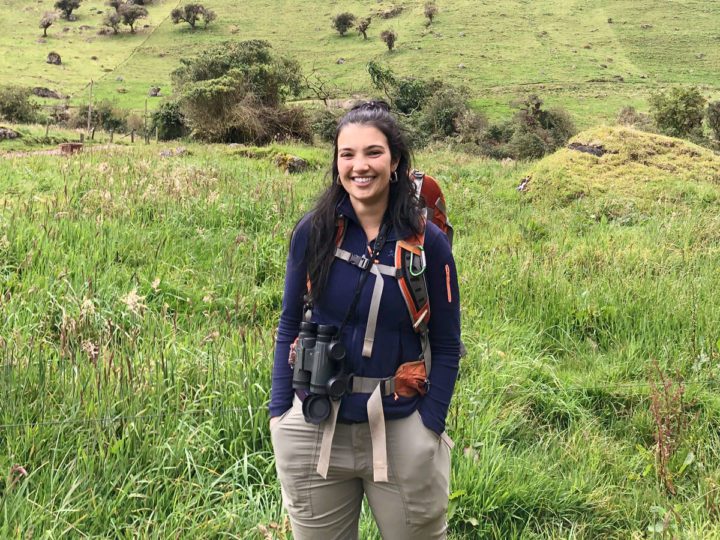Sarah Khalil
Postdoctoral Fellow
Expertise
Evolution • Sexual Selection • Genomics • Endocrinology
I use an integrative approach to understand how and why birds produce ornamentation, and specifically color. Currently, I study the the endocrine, genomic, and transcriptomic mechanisms of plumage color production in fairywrens, and how this color contributed to reproductive success.
Education
Ph.D, Ecology and Evolutionary Biology, Tulane University
B.S., Biological Sciences, Cornell University
Publications
2804417
Khalil
items
1
0
date
desc
title
14533
https://www.birds.cornell.edu/home/wp-content/plugins/zotpress/
%7B%22status%22%3A%22success%22%2C%22updateneeded%22%3Afalse%2C%22instance%22%3A%22zotpress-364c1d4675908f0b4eb837a12b46d461%22%2C%22meta%22%3A%7B%22request_last%22%3A0%2C%22request_next%22%3A0%2C%22used_cache%22%3Atrue%7D%2C%22data%22%3A%5B%7B%22key%22%3A%22JGSI9399%22%2C%22library%22%3A%7B%22id%22%3A2804417%7D%2C%22meta%22%3A%7B%22creatorSummary%22%3A%22Khalil%20et%20al.%22%2C%22parsedDate%22%3A%222023-04-01%22%2C%22numChildren%22%3A3%7D%2C%22bib%22%3A%22%3Cdiv%20class%3D%5C%22csl-bib-body%5C%22%20style%3D%5C%22line-height%3A%201.35%3B%20padding-left%3A%201em%3B%20text-indent%3A-1em%3B%5C%22%3E%5Cn%20%3Cdiv%20class%3D%5C%22csl-entry%5C%22%3EKhalil%2C%20S.%2C%20E.%20D.%20Enbody%2C%20C.%20Frankl-Vilches%2C%20J.%20F.%20Welklin%2C%20R.%20E.%20Koch%2C%20M.%20B.%20Toomey%2C%20S.%20Y.%20W.%20Sin%2C%20S.%20V.%20Edwards%2C%20M.%20Gahr%2C%20H.%20Schwabl%2C%20M.%20S.%20Webster%2C%20and%20J.%20Karubian%20%282023%29.%20%3Ca%20href%3D%27https%3A%5C%2F%5C%2Fdoi.org%5C%2F10.1093%5C%2Fmolbev%5C%2Fmsad056%27%3ETestosterone%20coordinates%20gene%20expression%20across%20different%20tissues%20to%20produce%20carotenoid-based%20red%20ornamentation%3C%5C%2Fa%3E.%20Molecular%20Biology%20and%20Evolution%2040%3Amsad056.%3C%5C%2Fdiv%3E%5Cn%3C%5C%2Fdiv%3E%22%2C%22data%22%3A%7B%22itemType%22%3A%22journalArticle%22%2C%22title%22%3A%22Testosterone%20coordinates%20gene%20expression%20across%20different%20tissues%20to%20produce%20carotenoid-based%20red%20ornamentation%22%2C%22creators%22%3A%5B%7B%22creatorType%22%3A%22author%22%2C%22firstName%22%3A%22Sarah%22%2C%22lastName%22%3A%22Khalil%22%7D%2C%7B%22creatorType%22%3A%22author%22%2C%22firstName%22%3A%22Erik%20D%22%2C%22lastName%22%3A%22Enbody%22%7D%2C%7B%22creatorType%22%3A%22author%22%2C%22firstName%22%3A%22Carolina%22%2C%22lastName%22%3A%22Frankl-Vilches%22%7D%2C%7B%22creatorType%22%3A%22author%22%2C%22firstName%22%3A%22Joseph%20F%22%2C%22lastName%22%3A%22Welklin%22%7D%2C%7B%22creatorType%22%3A%22author%22%2C%22firstName%22%3A%22Rebecca%20E%22%2C%22lastName%22%3A%22Koch%22%7D%2C%7B%22creatorType%22%3A%22author%22%2C%22firstName%22%3A%22Matthew%20B%22%2C%22lastName%22%3A%22Toomey%22%7D%2C%7B%22creatorType%22%3A%22author%22%2C%22firstName%22%3A%22Simon%20Yung%20Wa%22%2C%22lastName%22%3A%22Sin%22%7D%2C%7B%22creatorType%22%3A%22author%22%2C%22firstName%22%3A%22Scott%20V%22%2C%22lastName%22%3A%22Edwards%22%7D%2C%7B%22creatorType%22%3A%22author%22%2C%22firstName%22%3A%22Manfred%22%2C%22lastName%22%3A%22Gahr%22%7D%2C%7B%22creatorType%22%3A%22author%22%2C%22firstName%22%3A%22Hubert%22%2C%22lastName%22%3A%22Schwabl%22%7D%2C%7B%22creatorType%22%3A%22author%22%2C%22firstName%22%3A%22Michael%20S%22%2C%22lastName%22%3A%22Webster%22%7D%2C%7B%22creatorType%22%3A%22author%22%2C%22firstName%22%3A%22Jordan%22%2C%22lastName%22%3A%22Karubian%22%7D%5D%2C%22abstractNote%22%3A%22Carotenoid%20pigments%20underlie%20most%20of%20the%20red%2C%20orange%2C%20and%20yellow%20visual%20signals%20used%20in%20mate%20choice%20in%20vertebrates.%20However%2C%20many%20of%20the%20underlying%20processes%20surrounding%20the%20production%20of%20carotenoid-based%20traits%20remain%20unclear%20due%20to%20the%20complex%20nature%20of%20carotenoid%20uptake%2C%20metabolism%2C%20and%20deposition%20across%20tissues.%20Here%2C%20we%20leverage%20the%20ability%20to%20experimentally%20induce%20the%20production%20of%20a%20carotenoid-based%20red%20plumage%20patch%20in%20the%20red-backed%20fairywren%20%28Malurus%20melanocephalus%29%2C%20a%20songbird%20in%20which%20red%20plumage%20is%20an%20important%20male%20sexual%20signal.%20We%20experimentally%20elevated%20testosterone%20in%20unornamented%20males%20lacking%20red%20plumage%20to%20induce%20the%20production%20of%20ornamentation%20and%20compared%20gene%20expression%20in%20both%20the%20liver%20and%20feather%20follicles%20between%20unornamented%20control%20males%2C%20testosterone-implanted%20males%2C%20and%20naturally%20ornamented%20males.%20We%20show%20that%20testosterone%20upregulates%20the%20expression%20of%20CYP2J19%2C%20a%20gene%20known%20to%20be%20involved%20in%20ketocarotenoid%20metabolism%2C%20and%20a%20putative%20carotenoid%20processing%20gene%20%28ELOVL6%29%20in%20the%20liver%2C%20and%20also%20regulates%20the%20expression%20of%20putative%20carotenoid%20transporter%20genes%20in%20red%20feather%20follicles%20on%20the%20back%2C%20including%20ABCG1.%20In%20black%20feathers%2C%20carotenoid-related%20genes%20are%20downregulated%20and%20melanin%20genes%20upregulated%2C%20but%20we%20find%20that%20carotenoids%20are%20still%20present%20in%20the%20feathers.%20This%20may%20be%20due%20to%20the%20activity%20of%20the%20carotenoid-cleaving%20enzyme%20BCO2%20in%20black%20feathers.%20Our%20study%20provides%20a%20first%20working%20model%20of%20a%20pathway%20for%20carotenoid-based%20trait%20production%20in%20free-living%20birds%2C%20implicates%20testosterone%20as%20a%20key%20regulator%20of%20carotenoid-associated%20gene%20expression%2C%20and%20suggests%20hormones%20may%20coordinate%20the%20many%20processes%20that%20underlie%20the%20production%20of%20these%20traits%20across%20multiple%20tissues.%22%2C%22date%22%3A%222023-04-01%22%2C%22language%22%3A%22%22%2C%22DOI%22%3A%2210.1093%5C%2Fmolbev%5C%2Fmsad056%22%2C%22ISSN%22%3A%221537-1719%22%2C%22url%22%3A%22https%3A%5C%2F%5C%2Fdoi.org%5C%2F10.1093%5C%2Fmolbev%5C%2Fmsad056%22%2C%22collections%22%3A%5B%229BUGNQUJ%22%5D%2C%22dateModified%22%3A%222024-01-23T02%3A50%3A59Z%22%7D%7D%2C%7B%22key%22%3A%22XDIJRU6J%22%2C%22library%22%3A%7B%22id%22%3A2804417%7D%2C%22meta%22%3A%7B%22creatorSummary%22%3A%22Hendrix%20et%20al.%22%2C%22parsedDate%22%3A%222023-03-19%22%2C%22numChildren%22%3A0%7D%2C%22bib%22%3A%22%3Cdiv%20class%3D%5C%22csl-bib-body%5C%22%20style%3D%5C%22line-height%3A%201.35%3B%20padding-left%3A%201em%3B%20text-indent%3A-1em%3B%5C%22%3E%5Cn%20%3Cdiv%20class%3D%5C%22csl-entry%5C%22%3EHendrix%2C%20T.%20C.%2C%20F.%20Fernandez-Duque%2C%20S.%20Toner%2C%20L.%20G.%20Hitt%2C%20R.%20G.%20Thady%2C%20M.%20Massa%2C%20S.%20J.%20Hagler%2C%20M.%20Armfield%2C%20N.%20Clarke%2C%20P.%20Honscheid%2C%20S.%20Khalil%2C%20et%20al.%20%282023%29.%20%3Ca%20href%3D%27https%3A%5C%2F%5C%2Fdoi.org%5C%2F10.1080%5C%2F01584197.2023.2182224%27%3EBehavioural%20differences%20between%20ornamented%20and%20unornamented%20male%20Red-backed%20Fairywrens%20%28Malurus%20melanocephalus%29%20in%20the%20nonbreeding%20season%3C%5C%2Fa%3E.%20Emu%20-%20Austral%20Ornithology%200%3A1%5Cu20136.%3C%5C%2Fdiv%3E%5Cn%3C%5C%2Fdiv%3E%22%2C%22data%22%3A%7B%22itemType%22%3A%22journalArticle%22%2C%22title%22%3A%22Behavioural%20differences%20between%20ornamented%20and%20unornamented%20male%20Red-backed%20Fairywrens%20%28Malurus%20melanocephalus%29%20in%20the%20nonbreeding%20season%22%2C%22creators%22%3A%5B%7B%22creatorType%22%3A%22author%22%2C%22firstName%22%3A%22Trey%20C.%22%2C%22lastName%22%3A%22Hendrix%22%7D%2C%7B%22creatorType%22%3A%22author%22%2C%22firstName%22%3A%22Facundo%22%2C%22lastName%22%3A%22Fernandez-Duque%22%7D%2C%7B%22creatorType%22%3A%22author%22%2C%22firstName%22%3A%22Sarah%22%2C%22lastName%22%3A%22Toner%22%7D%2C%7B%22creatorType%22%3A%22author%22%2C%22firstName%22%3A%22Lauren%20G.%22%2C%22lastName%22%3A%22Hitt%22%7D%2C%7B%22creatorType%22%3A%22author%22%2C%22firstName%22%3A%22Robin%20G.%22%2C%22lastName%22%3A%22Thady%22%7D%2C%7B%22creatorType%22%3A%22author%22%2C%22firstName%22%3A%22Megan%22%2C%22lastName%22%3A%22Massa%22%7D%2C%7B%22creatorType%22%3A%22author%22%2C%22firstName%22%3A%22Samantha%20J.%22%2C%22lastName%22%3A%22Hagler%22%7D%2C%7B%22creatorType%22%3A%22author%22%2C%22firstName%22%3A%22Margaux%22%2C%22lastName%22%3A%22Armfield%22%7D%2C%7B%22creatorType%22%3A%22author%22%2C%22firstName%22%3A%22Nathalie%22%2C%22lastName%22%3A%22Clarke%22%7D%2C%7B%22creatorType%22%3A%22author%22%2C%22firstName%22%3A%22Phoebe%22%2C%22lastName%22%3A%22Honscheid%22%7D%2C%7B%22creatorType%22%3A%22author%22%2C%22firstName%22%3A%22Sarah%22%2C%22lastName%22%3A%22Khalil%22%7D%2C%7B%22creatorType%22%3A%22author%22%2C%22firstName%22%3A%22Carly%20E.%22%2C%22lastName%22%3A%22Hawkins%22%7D%2C%7B%22creatorType%22%3A%22author%22%2C%22firstName%22%3A%22Samantha%20M.%22%2C%22lastName%22%3A%22Lantz%22%7D%2C%7B%22creatorType%22%3A%22author%22%2C%22firstName%22%3A%22Joseph%20F.%22%2C%22lastName%22%3A%22Welklin%22%7D%2C%7B%22creatorType%22%3A%22author%22%2C%22firstName%22%3A%22John%20P.%22%2C%22lastName%22%3A%22Swaddle%22%7D%2C%7B%22creatorType%22%3A%22author%22%2C%22firstName%22%3A%22Michael%20S.%22%2C%22lastName%22%3A%22Webster%22%7D%2C%7B%22creatorType%22%3A%22author%22%2C%22firstName%22%3A%22Jordan%22%2C%22lastName%22%3A%22Karubian%22%7D%5D%2C%22abstractNote%22%3A%22During%20the%20breeding%20season%2C%20male%20Red-backed%20Fairywrens%20%28Malurus%20melanocephalus%29%20can%20exhibit%20ornamented%20%28red-black%29%20or%20unornamented%20%28brown%2C%20resembling%20females%20and%20juveniles%29%20plumage.%20These%20distinct%20plumage%20types%20represent%20alternative%20reproductive%20tactics%20and%20are%20associated%20with%20behavioural%20differences%20during%20the%20breeding%20season.%20However%2C%20we%20lack%20an%20understanding%20of%20whether%20and%20how%20these%20plumage%20types%20may%20be%20associated%20with%20behavioural%20differences%20during%20non-reproductive%20parts%20of%20the%20year.%20To%20fill%20this%20knowledge%20gap%2C%20we%20carried%20out%20behavioural%20observations%20during%20the%20nonbreeding%20season%20across%20three%20years.%20We%20hypothesised%20that%20ornamented%20plumage%20remains%20associated%20with%20mate%20attraction%20behaviours%20outside%20of%20the%20breeding%20season.%20We%20examined%20the%20investment%20of%20ornamented%2C%20moulting%2C%20and%20unornamented%20males%20in%20social%20behaviours%20and%20found%20that%20the%20three%20plumage%20types%20were%20largely%20similar%20in%20their%20behaviour%20except%20ornamented%20males%20courted%20and%2C%20to%20a%20lesser%20extent%2C%20allopreened%20at%20higher%20rates%20than%20unornamented%20males.%20Since%20concurrent%20work%20in%20the%20same%20study%20population%20demonstrates%20increased%20extra-pair%20fitness%20for%20males%20who%20moult%20into%20ornamented%20plumage%20early%2C%20we%20speculate%20that%20ornamentation%20and%20courtship%20behaviour%20may%20serve%20a%20mate%20attraction%20function%20outside%20of%20the%20breeding%20season.%20We%20argue%20that%20future%20studies%20should%20consider%20individual-level%20behavioural%20monitoring%20throughout%20the%20annual%20cycle%20to%20better%20quantify%20the%20complex%20selection%20pressures%20that%20lead%20to%20the%20coevolution%20of%20plumage%20moult%20and%20alternative%20reproductive%20tactics%20in%20this%20system.%22%2C%22date%22%3A%222023-03-19%22%2C%22language%22%3A%22%22%2C%22DOI%22%3A%2210.1080%5C%2F01584197.2023.2182224%22%2C%22ISSN%22%3A%220158-4197%22%2C%22url%22%3A%22https%3A%5C%2F%5C%2Fdoi.org%5C%2F10.1080%5C%2F01584197.2023.2182224%22%2C%22collections%22%3A%5B%229BUGNQUJ%22%5D%2C%22dateModified%22%3A%222024-01-23T02%3A50%3A59Z%22%7D%7D%2C%7B%22key%22%3A%225FEGHLJU%22%2C%22library%22%3A%7B%22id%22%3A2804417%7D%2C%22meta%22%3A%7B%22creatorSummary%22%3A%22Welklin%20et%20al.%22%2C%22parsedDate%22%3A%222023-01-01%22%2C%22numChildren%22%3A1%7D%2C%22bib%22%3A%22%3Cdiv%20class%3D%5C%22csl-bib-body%5C%22%20style%3D%5C%22line-height%3A%201.35%3B%20padding-left%3A%201em%3B%20text-indent%3A-1em%3B%5C%22%3E%5Cn%20%3Cdiv%20class%3D%5C%22csl-entry%5C%22%3EWelklin%2C%20J.%20F.%2C%20S.%20M.%20Lantz%2C%20S.%20Khalil%2C%20N.%20M.%20Moody%2C%20J.%20Karubian%2C%20and%20M.%20S.%20Webster%20%282023%29.%20%3Ca%20href%3D%27https%3A%5C%2F%5C%2Fdoi.org%5C%2F10.1093%5C%2Fbeheco%5C%2Farac110%27%3EPhotoperiod%20and%20rainfall%20are%20associated%20with%20seasonal%20shifts%20in%20social%20structure%20in%20a%20songbird%3C%5C%2Fa%3E.%20Behavioral%20Ecology%2034%3A136%5Cu2013149.%3C%5C%2Fdiv%3E%5Cn%3C%5C%2Fdiv%3E%22%2C%22data%22%3A%7B%22itemType%22%3A%22journalArticle%22%2C%22title%22%3A%22Photoperiod%20and%20rainfall%20are%20associated%20with%20seasonal%20shifts%20in%20social%20structure%20in%20a%20songbird%22%2C%22creators%22%3A%5B%7B%22creatorType%22%3A%22author%22%2C%22firstName%22%3A%22Joseph%20F%22%2C%22lastName%22%3A%22Welklin%22%7D%2C%7B%22creatorType%22%3A%22author%22%2C%22firstName%22%3A%22Samantha%20M%22%2C%22lastName%22%3A%22Lantz%22%7D%2C%7B%22creatorType%22%3A%22author%22%2C%22firstName%22%3A%22Sarah%22%2C%22lastName%22%3A%22Khalil%22%7D%2C%7B%22creatorType%22%3A%22author%22%2C%22firstName%22%3A%22Nicole%20M%22%2C%22lastName%22%3A%22Moody%22%7D%2C%7B%22creatorType%22%3A%22author%22%2C%22firstName%22%3A%22Jordan%22%2C%22lastName%22%3A%22Karubian%22%7D%2C%7B%22creatorType%22%3A%22author%22%2C%22firstName%22%3A%22Michael%20S%22%2C%22lastName%22%3A%22Webster%22%7D%5D%2C%22abstractNote%22%3A%22Seasonally%20breeding%20animals%20often%20exhibit%20different%20social%20structures%20during%20non-breeding%20and%20breeding%20periods%20that%20coincide%20with%20seasonal%20environmental%20variation%20and%20resource%20abundance.%20However%2C%20we%20know%20little%20about%20the%20environmental%20factors%20associated%20with%20when%20seasonal%20shifts%20in%20social%20structure%20occur.%20This%20lack%20of%20knowledge%20contrasts%20with%20our%20well-defined%20knowledge%20of%20the%20environmental%20cues%20that%20trigger%20a%20shift%20to%20breeding%20physiology%20in%20seasonally%20breeding%20species.%20Here%2C%20we%20identified%20some%20of%20the%20main%20environmental%20factors%20associated%20with%20seasonal%20shifts%20in%20social%20structure%20and%20initiation%20of%20breeding%20in%20the%20red-backed%20fairywren%20%28Malurus%20melanocephalus%29%2C%20an%20Australian%20songbird.%20Social%20network%20analyses%20revealed%20that%20social%20groups%2C%20which%20are%20highly%20territorial%20during%20the%20breeding%20season%2C%20interact%20in%20social%20%5Cu201ccommunities%5Cu201d%20on%20larger%20home%20ranges%20during%20the%20non-breeding%20season.%20Encounter%20rates%20among%20non-breeding%20groups%20were%20related%20to%20photoperiod%20and%20rainfall%2C%20with%20shifting%20photoperiod%20and%20increased%20rainfall%20associated%20with%20a%20shift%20toward%20territorial%20breeding%20social%20structure%20characterized%20by%20reductions%20in%20home%20range%20size%20and%20fewer%20encounters%20among%20non-breeding%20social%20groups.%20Similarly%2C%20onset%20of%20breeding%20was%20highly%20seasonal%20and%20was%20also%20associated%20with%20non-breeding%20season%20rainfall%2C%20with%20greater%20rainfall%20leading%20to%20earlier%20breeding.%20These%20findings%20reveal%20that%20for%20some%20species%2C%20the%20environmental%20factors%20associated%20with%20the%20timing%20of%20shifts%20in%20social%20structure%20across%20seasonal%20boundaries%20can%20be%20similar%20to%20those%20that%20determine%20timing%20of%20breeding.%20This%20study%20increases%20our%20understanding%20of%20the%20environmental%20factors%20associated%20with%20seasonal%20variation%20in%20social%20structure%20and%20how%20the%20timing%20of%20these%20shifts%20may%20respond%20to%20changing%20climates.%22%2C%22date%22%3A%222023-01-01%22%2C%22language%22%3A%22%22%2C%22DOI%22%3A%2210.1093%5C%2Fbeheco%5C%2Farac110%22%2C%22ISSN%22%3A%221465-7279%22%2C%22url%22%3A%22https%3A%5C%2F%5C%2Fdoi.org%5C%2F10.1093%5C%2Fbeheco%5C%2Farac110%22%2C%22collections%22%3A%5B%229BUGNQUJ%22%5D%2C%22dateModified%22%3A%222024-01-23T02%3A50%3A59Z%22%7D%7D%2C%7B%22key%22%3A%22VIMJBVF3%22%2C%22library%22%3A%7B%22id%22%3A2804417%7D%2C%22meta%22%3A%7B%22creatorSummary%22%3A%22Hitt%20et%20al.%22%2C%22parsedDate%22%3A%222023%22%2C%22numChildren%22%3A1%7D%2C%22bib%22%3A%22%3Cdiv%20class%3D%5C%22csl-bib-body%5C%22%20style%3D%5C%22line-height%3A%201.35%3B%20padding-left%3A%201em%3B%20text-indent%3A-1em%3B%5C%22%3E%5Cn%20%3Cdiv%20class%3D%5C%22csl-entry%5C%22%3EHitt%2C%20L.%20G.%2C%20S.%20Khalil%2C%20A.%20Blanchette%2C%20M.%20E.%20Finkelstein%2C%20E.%20N.%20K.%20Iverson%2C%20S.%20C.%20McClelland%2C%20R.%20Dur%5Cu00e3es%20Ribeiro%2C%20and%20J.%20Karubian%20%282023%29.%20%3Ca%20href%3D%27https%3A%5C%2F%5C%2Flinkinghub.elsevier.com%5C%2Fretrieve%5C%2Fpii%5C%2FS0013935123005030%27%3ELead%20exposure%20is%20correlated%20with%20reduced%20nesting%20success%20of%20an%20urban%20songbird%3C%5C%2Fa%3E.%20Environmental%20Research%20227%3A115711.%3C%5C%2Fdiv%3E%5Cn%3C%5C%2Fdiv%3E%22%2C%22data%22%3A%7B%22itemType%22%3A%22journalArticle%22%2C%22title%22%3A%22Lead%20exposure%20is%20correlated%20with%20reduced%20nesting%20success%20of%20an%20urban%20songbird%22%2C%22creators%22%3A%5B%7B%22creatorType%22%3A%22author%22%2C%22firstName%22%3A%22Lauren%20G.%22%2C%22lastName%22%3A%22Hitt%22%7D%2C%7B%22creatorType%22%3A%22author%22%2C%22firstName%22%3A%22Sarah%22%2C%22lastName%22%3A%22Khalil%22%7D%2C%7B%22creatorType%22%3A%22author%22%2C%22firstName%22%3A%22Annelise%22%2C%22lastName%22%3A%22Blanchette%22%7D%2C%7B%22creatorType%22%3A%22author%22%2C%22firstName%22%3A%22Myra%20E.%22%2C%22lastName%22%3A%22Finkelstein%22%7D%2C%7B%22creatorType%22%3A%22author%22%2C%22firstName%22%3A%22Erik%20N.K.%22%2C%22lastName%22%3A%22Iverson%22%7D%2C%7B%22creatorType%22%3A%22author%22%2C%22firstName%22%3A%22Stephanie%20C.%22%2C%22lastName%22%3A%22McClelland%22%7D%2C%7B%22creatorType%22%3A%22author%22%2C%22firstName%22%3A%22Renata%22%2C%22lastName%22%3A%22Dur%5Cu00e3es%20Ribeiro%22%7D%2C%7B%22creatorType%22%3A%22author%22%2C%22firstName%22%3A%22Jordan%22%2C%22lastName%22%3A%22Karubian%22%7D%5D%2C%22abstractNote%22%3A%22%22%2C%22date%22%3A%2206%5C%2F2023%22%2C%22language%22%3A%22en%22%2C%22DOI%22%3A%2210.1016%5C%2Fj.envres.2023.115711%22%2C%22ISSN%22%3A%2200139351%22%2C%22url%22%3A%22https%3A%5C%2F%5C%2Flinkinghub.elsevier.com%5C%2Fretrieve%5C%2Fpii%5C%2FS0013935123005030%22%2C%22collections%22%3A%5B%229BUGNQUJ%22%5D%2C%22dateModified%22%3A%222024-01-23T02%3A50%3A59Z%22%7D%7D%2C%7B%22key%22%3A%2282BIFURS%22%2C%22library%22%3A%7B%22id%22%3A2804417%7D%2C%22meta%22%3A%7B%22creatorSummary%22%3A%22Boersma%20et%20al.%22%2C%22parsedDate%22%3A%222022-12-31%22%2C%22numChildren%22%3A2%7D%2C%22bib%22%3A%22%3Cdiv%20class%3D%5C%22csl-bib-body%5C%22%20style%3D%5C%22line-height%3A%201.35%3B%20padding-left%3A%201em%3B%20text-indent%3A-1em%3B%5C%22%3E%5Cn%20%3Cdiv%20class%3D%5C%22csl-entry%5C%22%3EBoersma%2C%20J.%2C%20A.%20McQueen%2C%20A.%20Peters%2C%20J.%20F.%20Welklin%2C%20S.%20Khalil%2C%20R.%20Quispe%2C%20W.%20Goymann%2C%20and%20H.%20Schwabl%20%282022%29.%20%3Ca%20href%3D%27https%3A%5C%2F%5C%2Fwww.sciencedirect.com%5C%2Fscience%5C%2Farticle%5C%2Fpii%5C%2FS0016648022001496%27%3EUnexpected%20long-term%20retention%20of%20subcutaneous%20beeswax%20implants%20and%20additional%20notes%20on%20dose%20and%20composition%20from%20four%20testosterone%20implant%20studies%3C%5C%2Fa%3E.%20General%20and%20Comparative%20Endocrinology%20330%3A114124.%3C%5C%2Fdiv%3E%5Cn%3C%5C%2Fdiv%3E%22%2C%22data%22%3A%7B%22itemType%22%3A%22journalArticle%22%2C%22title%22%3A%22Unexpected%20long-term%20retention%20of%20subcutaneous%20beeswax%20implants%20and%20additional%20notes%20on%20dose%20and%20composition%20from%20four%20testosterone%20implant%20studies%22%2C%22creators%22%3A%5B%7B%22creatorType%22%3A%22author%22%2C%22firstName%22%3A%22Jordan%22%2C%22lastName%22%3A%22Boersma%22%7D%2C%7B%22creatorType%22%3A%22author%22%2C%22firstName%22%3A%22Alexandra%22%2C%22lastName%22%3A%22McQueen%22%7D%2C%7B%22creatorType%22%3A%22author%22%2C%22firstName%22%3A%22Anne%22%2C%22lastName%22%3A%22Peters%22%7D%2C%7B%22creatorType%22%3A%22author%22%2C%22firstName%22%3A%22Joseph%20F.%22%2C%22lastName%22%3A%22Welklin%22%7D%2C%7B%22creatorType%22%3A%22author%22%2C%22firstName%22%3A%22Sarah%22%2C%22lastName%22%3A%22Khalil%22%7D%2C%7B%22creatorType%22%3A%22author%22%2C%22firstName%22%3A%22Ren%5Cu00e9%22%2C%22lastName%22%3A%22Quispe%22%7D%2C%7B%22creatorType%22%3A%22author%22%2C%22firstName%22%3A%22Wolfgang%22%2C%22lastName%22%3A%22Goymann%22%7D%2C%7B%22creatorType%22%3A%22author%22%2C%22firstName%22%3A%22Hubert%22%2C%22lastName%22%3A%22Schwabl%22%7D%5D%2C%22abstractNote%22%3A%22Experimental%20manipulations%20of%20testosterone%20have%20advanced%20our%20understanding%20of%20the%20hormonal%20control%20of%20traits%20across%20vertebrates.%20Implants%20are%20commonly%20used%20to%20supplement%20testosterone%20and%20other%20hormones%20to%20organisms%2C%20as%20they%20can%20be%20readily%20scaled%20to%20produce%20desired%20hormone%20levels%20in%20circulation.%20Concerns%20about%20pharmacological%20%28i.e.%20unnatural%29%20doses%20of%20traditional%20silastic%20implants%20led%20to%20innovation%20in%20implant%20methods%2C%20with%20time-release%20pellets%20and%20beeswax%20implants%20proposed%20as%20solutions.%20A%20study%20comparing%20silastic%2C%20time-release%20pellets%2C%20and%20beeswax%20implants%20found%20the%20latter%20to%20be%20most%20effective%20in%20delivering%20a%20physiologically%20relevant%20dose.%20One%20proposed%20advantage%20to%20subcutaneous%20beeswax%20implants%20is%20that%20they%20are%20expected%20to%20degrade%20within%20the%20body%2C%20thus%20removing%20the%20obligation%20to%20recapture%20implanted%20individuals%20in%20the%20field.%20However%2C%20few%20studies%20have%20reported%20on%20dosage%20and%20no%20published%20literature%20has%20examined%20the%20assumption%20that%20beeswax%20implants%20readily%20degrade%20as%20expected.%20Here%20we%20present%20time-release%20androgen%20data%20in%20relation%20to%20implants%20containing%20varying%20levels%20of%20testosterone%20from%20four%20separate%20implant%20studies.%20In%20addition%2C%20we%20report%20long-term%20persistence%20of%20subcutaneous%20implants%2C%20including%20two%20cases%20of%20implants%20being%20retained%20for%5Cu00a0%3E%5Cu00a02%5Cu00a0years.%20Finally%2C%20we%20offer%20recommendations%20on%20the%20composition%20and%20implementation%20of%20beeswax%20implants%20to%20aid%20the%20pursuit%20of%20minimally%20invasive%20and%20physiologically%20relevant%20manipulations%20of%20circulating%20hormones.%22%2C%22date%22%3A%222022-12-31%22%2C%22language%22%3A%22en%22%2C%22DOI%22%3A%2210.1016%5C%2Fj.ygcen.2022.114124%22%2C%22ISSN%22%3A%220016-6480%22%2C%22url%22%3A%22https%3A%5C%2F%5C%2Fwww.sciencedirect.com%5C%2Fscience%5C%2Farticle%5C%2Fpii%5C%2FS0016648022001496%22%2C%22collections%22%3A%5B%22X6WG2SBA%22%2C%229BUGNQUJ%22%5D%2C%22dateModified%22%3A%222024-01-23T02%3A52%3A02Z%22%7D%7D%2C%7B%22key%22%3A%226ZHMN4R2%22%2C%22library%22%3A%7B%22id%22%3A2804417%7D%2C%22meta%22%3A%7B%22creatorSummary%22%3A%22Welklin%20et%20al.%22%2C%22parsedDate%22%3A%222021-12-01%22%2C%22numChildren%22%3A2%7D%2C%22bib%22%3A%22%3Cdiv%20class%3D%5C%22csl-bib-body%5C%22%20style%3D%5C%22line-height%3A%201.35%3B%20padding-left%3A%201em%3B%20text-indent%3A-1em%3B%5C%22%3E%5Cn%20%3Cdiv%20class%3D%5C%22csl-entry%5C%22%3EWelklin%2C%20J.%20F.%2C%20S.%20M.%20Lantz%2C%20S.%20Khalil%2C%20N.%20M.%20Moody%2C%20J.%20Karubian%2C%20and%20M.%20S.%20Webster%20%282021%29.%20%3Ca%20href%3D%27https%3A%5C%2F%5C%2Fwww.sciencedirect.com%5C%2Fscience%5C%2Farticle%5C%2Fpii%5C%2FS0003347221003250%27%3ESocial%20and%20abiotic%20factors%20differentially%20affect%20plumage%20ornamentation%20of%20young%20and%20old%20males%20in%20an%20Australian%20songbird%3C%5C%2Fa%3E.%20Animal%20Behaviour%20182%3A173%5Cu2013188.%3C%5C%2Fdiv%3E%5Cn%3C%5C%2Fdiv%3E%22%2C%22data%22%3A%7B%22itemType%22%3A%22journalArticle%22%2C%22title%22%3A%22Social%20and%20abiotic%20factors%20differentially%20affect%20plumage%20ornamentation%20of%20young%20and%20old%20males%20in%20an%20Australian%20songbird%22%2C%22creators%22%3A%5B%7B%22creatorType%22%3A%22author%22%2C%22firstName%22%3A%22Joseph%20F.%22%2C%22lastName%22%3A%22Welklin%22%7D%2C%7B%22creatorType%22%3A%22author%22%2C%22firstName%22%3A%22Samantha%20M.%22%2C%22lastName%22%3A%22Lantz%22%7D%2C%7B%22creatorType%22%3A%22author%22%2C%22firstName%22%3A%22Sarah%22%2C%22lastName%22%3A%22Khalil%22%7D%2C%7B%22creatorType%22%3A%22author%22%2C%22firstName%22%3A%22Nicole%20M.%22%2C%22lastName%22%3A%22Moody%22%7D%2C%7B%22creatorType%22%3A%22author%22%2C%22firstName%22%3A%22Jordan%22%2C%22lastName%22%3A%22Karubian%22%7D%2C%7B%22creatorType%22%3A%22author%22%2C%22firstName%22%3A%22Michael%20S.%22%2C%22lastName%22%3A%22Webster%22%7D%5D%2C%22abstractNote%22%3A%22Both%20abiotic%20environmental%20conditions%20and%20variation%20in%20social%20environment%20are%20known%20to%20impact%20the%20acquisition%20of%20sexual%20signals.%20However%2C%20the%20influences%20of%20abiotic%20environmental%20and%20social%20factors%20are%20rarely%20compared%20to%20each%20other.%20Here%20we%20test%20the%20relative%20importance%20of%20these%20factors%20in%20determining%20whether%20and%20when%20male%20red-backed%20fairy-wrens%2C%20Malurus%20melanocephalus%2C%20moult%20into%20ornamented%20breeding%20plumage%2C%20a%20known%20sexual%20signal.%20One-year-old%20male%20red-backed%20fairy-wrens%20vary%20in%20whether%20or%20not%20they%20acquire%20ornamentation%2C%20whereas%20males%20age%202%20years%20and%20older%20vary%20in%20their%20timing%20of%20ornament%20acquisition.%20It%20is%20unclear%20whether%20these%20processes%20are%20determined%20by%20the%20same%20or%20different%20factors%2C%20and%20we%20examined%20both%20events%20using%20a%20combination%20of%20long-term%20breeding%20records%20and%20nonbreeding%20social%20networks.%20We%20found%20that%201-year-old%20males%20that%20paired%20prior%20to%20the%20start%20of%20the%20breeding%20season%20were%20more%20likely%20to%20acquire%20ornamented%20plumage%2C%20but%20rainfall%20did%20not%20influence%20whether%201-year-old%20males%20acquired%20ornamented%20plumage.%20Thus%2C%20for%20young%20individuals%2C%20social%20cues%20appear%20to%20play%20a%20larger%20role%20than%20abiotic%20environmental%20factors%20in%20determining%20ornament%20acquisition.%20For%20older%20males%2C%20timing%20of%20ornamented%20plumage%20acquisition%20was%20constrained%20by%20rainfall%2C%20with%20drier%20nonbreeding%20seasons%20leading%20to%20poorer%20physiological%20condition%20and%20later%20moult%20dates.%20Thus%2C%20sexual%20signal%20variation%20in%20older%20males%20appears%20to%20be%20a%20condition-dependent%20trait%2C%20driven%20by%20abiotic%20environmental%20and%20physiological%20factors%20rather%20than%20social%20cues.%20These%20findings%20reveal%20that%20factors%20influencing%20sexual%20signal%20expression%20can%20vary%20with%20age%20when%20age%20classes%20exhibit%20different%20forms%20of%20signal%20variation.%20Our%20results%20suggest%20that%20social%20environment%20may%20drive%20sexual%20signal%20variation%20in%20young%20individuals%2C%20whereas%20abiotic%20environmental%20variation%20may%20drive%20sexual%20signal%20variation%20in%20older%20individuals.%22%2C%22date%22%3A%222021-12-01%22%2C%22language%22%3A%22en%22%2C%22DOI%22%3A%2210.1016%5C%2Fj.anbehav.2021.10.007%22%2C%22ISSN%22%3A%220003-3472%22%2C%22url%22%3A%22https%3A%5C%2F%5C%2Fwww.sciencedirect.com%5C%2Fscience%5C%2Farticle%5C%2Fpii%5C%2FS0003347221003250%22%2C%22collections%22%3A%5B%22MN9HPYUE%22%2C%22DI2RPYXK%22%5D%2C%22dateModified%22%3A%222022-10-31T19%3A52%3A18Z%22%7D%7D%2C%7B%22key%22%3A%22DFS3KM22%22%2C%22library%22%3A%7B%22id%22%3A2804417%7D%2C%22meta%22%3A%7B%22creatorSummary%22%3A%22Khalil%20et%20al.%22%2C%22parsedDate%22%3A%222020-09-30%22%2C%22numChildren%22%3A2%7D%2C%22bib%22%3A%22%3Cdiv%20class%3D%5C%22csl-bib-body%5C%22%20style%3D%5C%22line-height%3A%201.35%3B%20padding-left%3A%201em%3B%20text-indent%3A-1em%3B%5C%22%3E%5Cn%20%3Cdiv%20class%3D%5C%22csl-entry%5C%22%3EKhalil%2C%20S.%2C%20J.%20F.%20Welklin%2C%20K.%20J.%20McGraw%2C%20J.%20Boersma%2C%20H.%20Schwabl%2C%20M.%20S.%20Webster%2C%20and%20J.%20Karubian%20%282020%29.%20%3Ca%20href%3D%27https%3A%5C%2F%5C%2Froyalsocietypublishing.org%5C%2Fdoi%5C%2Ffull%5C%2F10.1098%5C%2Frspb.2020.1687%27%3ETestosterone%20regulates%20CYP2J19-linked%20carotenoid%20signal%20expression%20in%20male%20Red-backed%20Fairy-wrens%20%28%3Ci%3EMalurus%20melanocephalus%3C%5C%2Fi%3E%29%3C%5C%2Fa%3E.%20Proceedings%20of%20the%20Royal%20Society%20B%3A%20Biological%20Sciences%20287%3A20201687.%3C%5C%2Fdiv%3E%5Cn%3C%5C%2Fdiv%3E%22%2C%22data%22%3A%7B%22itemType%22%3A%22journalArticle%22%2C%22title%22%3A%22Testosterone%20regulates%20CYP2J19-linked%20carotenoid%20signal%20expression%20in%20male%20Red-backed%20Fairy-wrens%20%28%3Ci%3EMalurus%20melanocephalus%3C%5C%2Fi%3E%29%22%2C%22creators%22%3A%5B%7B%22creatorType%22%3A%22author%22%2C%22firstName%22%3A%22Sarah%22%2C%22lastName%22%3A%22Khalil%22%7D%2C%7B%22creatorType%22%3A%22author%22%2C%22firstName%22%3A%22Joseph%20F.%22%2C%22lastName%22%3A%22Welklin%22%7D%2C%7B%22creatorType%22%3A%22author%22%2C%22firstName%22%3A%22Kevin%20J.%22%2C%22lastName%22%3A%22McGraw%22%7D%2C%7B%22creatorType%22%3A%22author%22%2C%22firstName%22%3A%22Jordan%22%2C%22lastName%22%3A%22Boersma%22%7D%2C%7B%22creatorType%22%3A%22author%22%2C%22firstName%22%3A%22Hubert%22%2C%22lastName%22%3A%22Schwabl%22%7D%2C%7B%22creatorType%22%3A%22author%22%2C%22firstName%22%3A%22Michael%20S.%22%2C%22lastName%22%3A%22Webster%22%7D%2C%7B%22creatorType%22%3A%22author%22%2C%22firstName%22%3A%22Jordan%22%2C%22lastName%22%3A%22Karubian%22%7D%5D%2C%22abstractNote%22%3A%22Carotenoid%20pigments%20produce%20most%20red%2C%20orange%20and%20yellow%20colours%20in%20vertebrates.%20This%20coloration%20can%20serve%20as%20an%20honest%20signal%20of%20quality%20that%20mediates%20social%20and%20mating%20interactions%2C%20but%20our%20understanding%20of%20the%20underlying%20mechanisms%20that%20control%20carotenoid%20signal%20production%2C%20including%20how%20different%20physiological%20pathways%20interact%20to%20shape%20and%20maintain%20these%20signals%2C%20remains%20incomplete.%20We%20investigated%20the%20role%20of%20testosterone%20in%20mediating%20gene%20expression%20associated%20with%20a%20red%20plumage%20sexual%20signal%20in%20red-backed%20fairywrens%20%28Malurus%20melanocephalus%29.%20In%20this%20species%2C%20males%20within%20a%20single%20population%20can%20flexibly%20produce%20either%20red%5C%2Fblack%20nuptial%20plumage%20or%20female-like%20brown%20plumage.%20Combining%20correlational%20analyses%20with%20a%20field-based%20testosterone%20implant%20experiment%20and%20quantitative%20polymerase%20chain%20reaction%2C%20we%20show%20that%20testosterone%20mediates%20expression%20of%20carotenoid-based%20plumage%20in%20part%20by%20regulating%20expression%20of%20CYP2J19%2C%20a%20ketolase%20gene%20associated%20with%20ketocarotenoid%20metabolism%20and%20pigmentation%20in%20birds.%20This%20is%2C%20to%20our%20knowledge%2C%20the%20first%20time%20that%20hormonal%20regulation%20of%20a%20specific%20genetic%20locus%20has%20been%20linked%20to%20carotenoid%20production%20in%20a%20natural%20context%2C%20revealing%20how%20endocrine%20mechanisms%20produce%20sexual%20signals%20that%20shape%20reproductive%20success.%22%2C%22date%22%3A%22September%2030%2C%202020%22%2C%22language%22%3A%22%22%2C%22DOI%22%3A%2210.1098%5C%2Frspb.2020.1687%22%2C%22ISSN%22%3A%22%22%2C%22url%22%3A%22https%3A%5C%2F%5C%2Froyalsocietypublishing.org%5C%2Fdoi%5C%2Ffull%5C%2F10.1098%5C%2Frspb.2020.1687%22%2C%22collections%22%3A%5B%22WP8LXBYC%22%5D%2C%22dateModified%22%3A%222021-04-09T20%3A42%3A36Z%22%7D%7D%5D%7D
Khalil, S., E. D. Enbody, C. Frankl-Vilches, J. F. Welklin, R. E. Koch, M. B. Toomey, S. Y. W. Sin, S. V. Edwards, M. Gahr, H. Schwabl, M. S. Webster, and J. Karubian (2023). Testosterone coordinates gene expression across different tissues to produce carotenoid-based red ornamentation. Molecular Biology and Evolution 40:msad056.
Hendrix, T. C., F. Fernandez-Duque, S. Toner, L. G. Hitt, R. G. Thady, M. Massa, S. J. Hagler, M. Armfield, N. Clarke, P. Honscheid, S. Khalil, et al. (2023). Behavioural differences between ornamented and unornamented male Red-backed Fairywrens (Malurus melanocephalus) in the nonbreeding season. Emu - Austral Ornithology 0:1–6.
Welklin, J. F., S. M. Lantz, S. Khalil, N. M. Moody, J. Karubian, and M. S. Webster (2023). Photoperiod and rainfall are associated with seasonal shifts in social structure in a songbird. Behavioral Ecology 34:136–149.
Hitt, L. G., S. Khalil, A. Blanchette, M. E. Finkelstein, E. N. K. Iverson, S. C. McClelland, R. Durães Ribeiro, and J. Karubian (2023). Lead exposure is correlated with reduced nesting success of an urban songbird. Environmental Research 227:115711.
Boersma, J., A. McQueen, A. Peters, J. F. Welklin, S. Khalil, R. Quispe, W. Goymann, and H. Schwabl (2022). Unexpected long-term retention of subcutaneous beeswax implants and additional notes on dose and composition from four testosterone implant studies. General and Comparative Endocrinology 330:114124.
Welklin, J. F., S. M. Lantz, S. Khalil, N. M. Moody, J. Karubian, and M. S. Webster (2021). Social and abiotic factors differentially affect plumage ornamentation of young and old males in an Australian songbird. Animal Behaviour 182:173–188.
Khalil, S., J. F. Welklin, K. J. McGraw, J. Boersma, H. Schwabl, M. S. Webster, and J. Karubian (2020). Testosterone regulates CYP2J19-linked carotenoid signal expression in male Red-backed Fairy-wrens (Malurus melanocephalus). Proceedings of the Royal Society B: Biological Sciences 287:20201687.

Sarah Khalil
Postdoctoral Fellow
Postdoctoral Fellow
Center
Biodiversity Studies & Higher Education
Email sk2423@cornell.edu
Website Google Scholar
